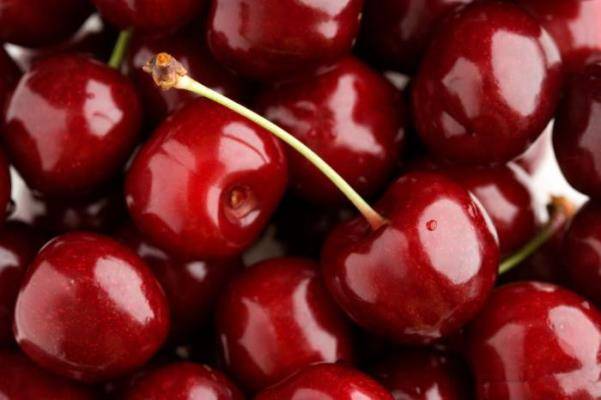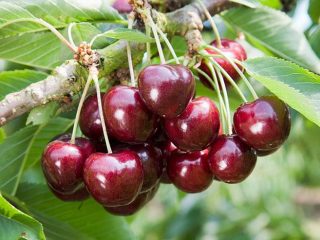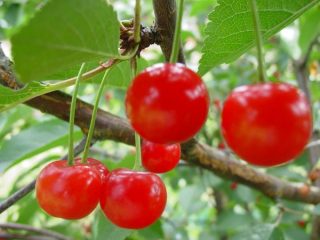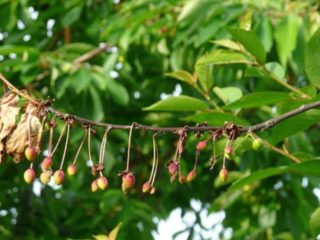Content
When creating new cherry varieties, great importance is given to resistance to low temperatures and coccomycosis. Of course, the yield should be good, and the berries should correspond to their purpose - dessert berries should be large in size and good taste, technical berries should have a high content of nutrients. One of the best universal varieties is Kharitonovskaya cherry.
History of selection
Institute named after Michurina in 1992 filed an application for registration of the Kharitonovskaya variety. In 1998, cherries were accepted by the State Register. Its authors are E. N. Kharitonova and O. S. Zhukov. Cherry Kharitonovskaya was created by crossing Almaz with Zhukovskaya. The first variety originates from the basic hybrid Padocerus-M, the second - Duke (cherry-cherry).
Ivan Michurin was the first to cross these species. Modern cerapadus (the mother tree is cherry) and padocerus are very different from the first varieties. They are characterized by good taste and increased resistance to coccomycosis. All hybrids, regardless of the maternal species, are classified as cherries. The Kharitonovskaya variety is considered one of the most successful.
Description of culture
The height of the Kharitonovskaya cherry tree reaches 2.5-3 m. Straight brown-brown, medium-leafed branches form a sparse spherical crown. Large, smooth leaves with a sharp tip and a rounded base are dark green. The leaf blade is straight, with medium-sized stipules and a serrated edge.
The flowers of the Kharitonovskaya cherry are white and large. The berries are large, one-dimensional, weighing about 5 g each. The color of the round fruits is dark red, almost black when fully ripe. The pulp of Kharitonovskaya is orange, the juice is coral in color. The taste of cherries of this variety is rated 4.7 points, sweet and sour. The fruits are firmly attached to the stalk, but come off easily and cleanly. The stone is large, oval, and easily separated from the pulp.
Kharitonovskaya is recommended by the State Register for cultivation in the Central Black Earth region. The variety is often used as a rootstock for other cherries.
Brief characteristics of the variety
Kharitonovskaya cherry is an excellent variety for the southern and central regions. It can be grown in amateur gardens and farms.
Drought resistance, winter hardiness
The Kharitonovskaya variety is drought-resistant. This does not mean that in the hot summer the variety does not need moisture at all - watering is carried out 1-2 times a month. Frost resistance of Kharitonovskaya is assessed as average; it is unsuitable for growing in cold climates.
Pollination, flowering period, ripening time
The ripening period of Kharitonovskaya cherries is average. It blooms at the end of spring, the ovaries form on bouquet branches or last year's shoots. The variety is partially self-fertile. This means that without pollinators, 5 to 20% of flowers turn into berries. To get a good harvest, you need to plant the Vladimirskaya or Zhukovskaya varieties nearby. The first berries ripen in mid-July.
Productivity, fruiting
The first harvest of Kharitonovskaya cherries is carried out 5 years after planting - it is not classified as early-bearing. But then the variety produces berries every year.
With good agricultural technology, the yield of Kharitonovskaya cherries is 15-20 kg per tree. After ripening, the berries do not fall off the tree, but are separated from the stalk cleanly and easily. Transportability of Kharitonovskaya is average.
Area of application of berries
Despite the fact that not everyone likes the light aroma of bird cherry, reviews of the taste of Kharitonovskaya cherries are high. Its purpose is universal - the berries are eaten fresh, juices, winter preparations, and wines are made from them.
Resistance to diseases and pests
The Kharitonovskaya variety is highly resistant to coccomycosis. This makes it attractive for growing in areas where cherry trees are heavily affected by disease. Pest infestation is average.
Advantages and disadvantages
The Kharitonovskaya variety is a hybrid that successfully combines the genes of cherries, sweet cherries, and bird cherry. It has taken the best qualities from these species and has:
- High resistance to coccomycosis.
- Partially self-fertile.
- Large berries.
- Stability of fruiting.
- High yield.
- Compact tree size.
- Good berry taste.
- The harvest does not fall off after ripening, but is separated from the stalk with a dry separation.
- The versatility of using berries.
- Drought resistance.
Among the disadvantages it should be noted:
- Average frost resistance.
- A large bone.
- Average transportability of fruits.
Landing Features
In the Central Black Earth region, reviews from summer residents about the Kharitonovskaya cherry characterize it as an undemanding crop. The main thing is to choose the right place and plant the tree.
Recommended timing and selection of a suitable location
The place where Kharitonovskaya cherries can be planted should be sunny, groundwater should not come closer to the surface than 2 meters. The tree can be planted on the south side of the fence or on the western slope with a slope angle of no more than 15⁰ (ideally 8⁰).
The optimal soil is light loam with a neutral reaction. You can improve the soil by adding humus, sand, lime, and fertilizers.
In the southern regions, Kharitonovskaya can be planted in the fall, after leaf fall. In the north of the region, cherries are placed on the site in early spring. Excavation work must be completed before the buds open. Therefore, it makes sense to bury a tree purchased in the fall until spring, dig a planting hole, and as soon as the snow melts, move it to a permanent place.
What crops can and cannot be planted next to cherries?
Any cherry variety should be planted near pollinators. For Kharitonovskaya, Zhukovskaya and Vladimirskaya will be good “neighbors”. You can place the seedling not far from other stone fruit crops. The main thing is that the trees do not shade each other, and that the crowns are well ventilated.
You cannot plant shrubs with a strong, quickly spreading root system next to cherries. Raspberries, sea buckthorn, and blackberries will quickly “take over” the area. Their roots will compete with cherry trees for water and fertilizer. Maple, linden, birch, and oak emit substances that inhibit the development of fruit trees. Nightshade crops - tomato, eggplant, potato - will themselves suffer from lack of light in the shade of the cherry tree. In addition, they will “share” their sores with the latter.
The root of an adult cherry can be covered from overheating or to preserve moisture by plants that develop only the top layer of soil - tenacious, hoofed grass, periwinkle, budra.
Selection and preparation of planting material
Cherries should be purchased from trusted producers who grow planting material in your region or a little further north. Southern trees do not take root well in areas whose climate is noticeably cooler than their homeland.
When choosing seedlings you need to pay attention to:
- To the root system. It should be well developed and intact.
- To the height of the seedlings. The normal height of a one-year-old is about 80 cm, and that of a two-year-old is 110 cm.
- The color of the bark. A greenish color indicates that a lot of nitrogen was used when growing the cherry. This means that the seedling will almost certainly die in the first winter.
Landing algorithm
Before planting, the cherry root is soaked for at least 3 hours. It is good if root or heteroauxin is added to the water. Planting is carried out in the following sequence:
- The pit is prepared so that the root of the seedling can be freely placed in it. Standard sizes are depth from 40 to 60 cm, diameter about 80 cm.
- A bucket of humus and starting fertilizers - 50 g of phosphorus and potassium each - are added to the top layer of soil removed when preparing the pit.If the soil suffers from excess clay, add sand. Sour is improved with lime.
- A strong peg for gartering the cherry is driven in near the center of the hole.
- The seedling is placed in the center and gradually covered with fertile soil, tamping it with the handle of a shovel so as not to damage the root. The neck should rise 5-7 cm above the surface.
- A roller is formed from the remaining soil, and the seedling is watered with 2-3 buckets of water.
- When the moisture is absorbed, the tree trunk circle is mulched.
Subsequent care of the crop
Regular watering to prevent the soil from drying out is needed in the first growing season. Subsequently, the cherries are watered only if there is no rain for a long time. In the fall, be sure to do moisture recharging, which allows the tree to safely overwinter.
Cherries can be fertilized with mineral fertilizers, taking into account that a lot of nitrogen and potassium are needed, and little phosphorus. The crop responds well to manure. Instead of a mineral complex, you can mulch the tree trunk circle with waste products of cattle, adding a can of ash. These organic fertilizers contain just a large amount of nitrogen and potassium, but there is little phosphorus, but enough for cherries.
To obtain a good harvest, the crop needs not only sanitary, but also formative pruning. They need to be carried out from the first years of life. They will not only allow you to form a crown convenient for harvesting, but will also improve the quality of the berries and reduce the susceptibility to pathogens of fungal diseases.
The Kharitonovskaya variety grows in areas where there is no need to cover the tree for the winter. To protect against hares, the trunk is wrapped in burlap or other material.
Diseases and pests, methods of control and prevention
The characteristics of Kharitonovskaya cherry as a variety resistant to coccomycosis do not allow us to do without preventive treatments.
Disease | External signs | Treatments | Prevention |
Coccomycosis | Dark spots appear on the upper part of the leaf, and a grayish-brown coating appears on the lower part. Then the diseased part falls out. By mid-summer, the entire leaf falls off | When the buds open, the cherries are treated with copper oxychloride; after leaf fall, they are sprayed with iron sulfate | Fallen leaves are removed from the site, and sanitary and formative pruning is carried out regularly. |
Moniliosis | The cherry tree appears to have been damaged by fire. Entire branches dry out, starting with flowers and young leaves | The affected branches are cut out, taking part of the healthy tissue. The tree is treated with copper-containing preparations | |
Rust | Fluffy red spots appear on the upper part of the leaf blade | Treatment with copper-containing preparations |
Among the pests, the tree is affected by aphids and cherry sawfly. Their invasion will be stopped by spraying with appropriate insecticides.
The Kharitonovskaya variety is a promising cherry for growing in warm and temperate climates. It has large, tasty, universal berries and rarely suffers from coccomycosis.

























